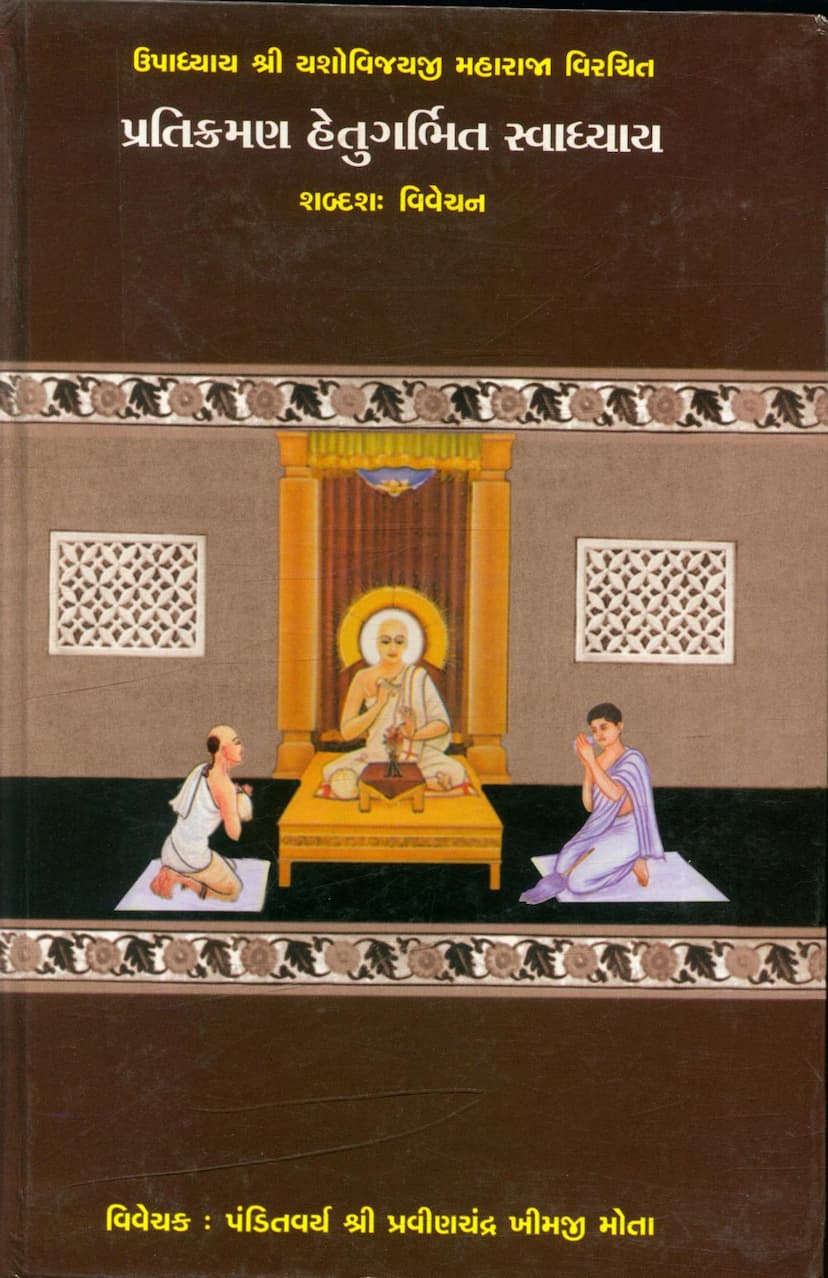Pratikraman Hetu Garbhit Swadhyay
Added to library: September 2, 2025

Summary
Here is a comprehensive summary of the Jain text "Pratikraman Hetu Garbhit Swadhyay" by Pravin K Mota, based on the provided pages:
Book Title: Pratikraman Hetu Garbhit Swadhyay (પ્રતિક્રમણ હેતુગર્ભિત સ્વાધ્યાય) Author (Original): Upadhyay Shri Yashovijayji Maharaj (ઉપાધ્યાય શ્રી યશોવિજયજી મહારાજા) Commentator/Analyst: Panditvarya Shri Pravinchandra Khimji Mota (પંડિતવર્ય શ્રી પ્રવીણચંદ્ર ખીમજી મોતા) Publisher: Gitarth Ganga (ગીતાર્થ ગંગા)
Overall Purpose and Significance:
The book is a detailed, word-by-word commentary (શબ્દશઃ વિવેચન) on the original work by Upadhyay Shri Yashovijayji Maharaj. The central theme is Pratikraman, a fundamental Jain ritual involving repentance and atonement for transgressions. The commentary aims to deeply explain the underlying reasons (hetu) and principles behind each step and verse of Pratikraman, making the practice more meaningful and effective for the practitioner. The publisher, Gitarth Ganga, is dedicated to illuminating the profound secrets of Jainism through extensive scriptural research and accessible explanations.
Key Concepts and Structure:
-
The Importance of Pratikraman: The text emphasizes that merely obtaining Jainism is not enough; understanding its profound secrets through knowledge is crucial. Pratikraman, involving the six essential daily duties (Samaayik and other Aavashyaks), is presented as a vital practice leading from Samayik (equanimity) to Sarvavirati (complete renunciation) and ultimately to Vitraagta (passionlessness) and Kevalgnan (omniscience), leading to liberation from suffering.
-
Commentary on Upadhyay Yashovijayji's Work: The book is a detailed analysis of a Sajhaye (a devotional song or composition, often used for teaching) by Upadhyay Yashovijayji Maharaj. This particular Sajhaye is dedicated to explaining the "reasons" or "purpose" behind Pratikraman. The commentator, Pravinchandra Mota, provides an in-depth explanation of each verse and concept.
-
The Six Aavashyaks (Essential Duties): The text details the significance of the six daily Aavashyaks, which form the core of Pratikraman:
- Samaayik (સામાયિક): Cultivating equanimity and equanimity towards all beings.
- Chaturvishththho (ચઉવિસત્થો): Striving for equanimity by meditating on the virtues of the 24 Tirthankaras.
- Vandan (વંદન): Showing respect and devotion to the enlightened beings (gurus/monks).
- Pratikraman (પ્રતિક્રમણ): The act of turning back from sins and atonement for transgressions.
- Kayotsarga (કાયોત્સર્ગ): The practice of bodily stillness and meditation, often used for purification.
- Pachchakhan (પચ્ચક્ખાણ): Vows or resolutions to abstain from certain actions.
-
Detailed Explanation of Pratikraman Rituals: The book breaks down the Pratikraman process, including:
- Timing: Explaining the appropriate times for performing Pratikraman (day and night, with exceptions).
- Devotional Practices: Describing the procedures for Devavandan (worship of deities) and Guruvandan (worship of gurus), including the significance of specific verses and khamasamana (acts of humility and apology).
- Purification of Sins: Illustrating how each of the six Aavashyaks contributes to the purification of different types of transgressions (aticharas) related to Darshanachar (faith conduct), Gyanachar (knowledge conduct), Charitraachar (conduct), Tapachar (asceticism), and Viryachar (energy conduct).
- The Role of Kayotsarga: Highlighting how Kayotsarga plays a crucial role in purifying lingering faults not addressed by earlier steps.
- The Meaning of Pratikraman: Exploring various synonyms for Pratikraman like Pratikaran, Varana, Nivrutti, Ninda, Garha, and Shuddhi, each explained with illustrative stories and examples to convey the deeper meaning.
- Distinction between Day and Night Pratikraman: Detailing the specific practices and intentions for morning (Devasik) and evening (Ratriya) Pratikramans.
- The Significance of Sajhaye and Stotras: Explaining the devotional songs and verses recited during the ritual, including the joy expressed by the original author upon completing the Sajhaye and the concluding devotional verses.
-
Illustrative Stories and Examples: The commentator uses various analogies and stories to clarify the abstract concepts. These include:
- The analogy of a torch and its user to explain the need for knowledge alongside faith.
- Stories of various types of purification and the importance of sincere intent.
- Specific examples from Jain scriptures to illustrate the meaning of different verses and practices.
- The story of the painter's daughter and the king to highlight the power of intellect and timely action.
- The story of the merchant and his palace to illustrate the importance of protecting and maintaining spiritual discipline.
- The story of the adulterous wife and the different suitors, reflecting the consequences of past actions and the need for discernment.
- The story of the student and the teacher to emphasize the role of sincere effort in understanding and acting upon spiritual teachings.
- The story of the potter's daughter and the king's vow to illustrate the seriousness of vows and commitments.
- The story of the poisonous well and the antidote to explain how spiritual practices counteract negative karma.
-
Commentator's Approach: Panditvarya Shri Pravinchandra Mota's commentary is characterized by its thoroughness, clarity, and reverence for the original text. He connects the practical rituals of Pratikraman to the core philosophical tenets of Jainism, making it relatable and inspiring for the modern reader. The introduction by the publisher highlights their mission to make profound spiritual knowledge accessible.
In essence, "Pratikraman Hetu Garbhit Swadhyay" is a scholarly yet devotional guide that seeks to transform the ritualistic performance of Pratikraman into a deeply understood and spiritually enriching practice, fostering a genuine connection with the Jain path to liberation.